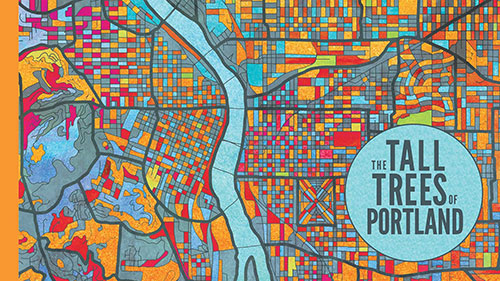Patrick McDonald is an Ooligan graduate and the owner of Overcup Press here in Portland. Recently I had a chance to sit down and talk with him about their beautiful new art book, The Tall Trees of Portland by Matt Wagner of Hellion Gallery.
Thank you so much for taking the time to speak with me today. The Tall Trees of Portland is a beautiful book. What really made it fascinating for me were the whimsical surveys and glimpses into each artist’s workspace. Where did that idea come from?
Matt and I hatched up the idea together. We had the intention of doing it with our first book, The Tall Trees of Tokyo, but it was too difficult to coordinate photography on the international level. With this book we were on our home turf, so it was much easier. Our idea was to have an environmental shot, followed by the survey, and then four pages of art. It was an expansion from the Tokyo book, and we doubled the amount of real estate for the art. We were able to do more full bleeds and saturate the pages with color.
I notice The Tall Trees of Portland is the same trim size and price point as the Tokyo book, but the page count is much higher. How were you able to manage that?
With the Tokyo book there was the added expense of having to go to Tokyo. Since we didn’t have that with the Portland book, we were able to bump up the page count. We also pulled out the gatefolds because we wanted to make sure all the artists were equally represented. There are some who are at the top of their game and have quite a bit of notoriety, and others who are equally as talented but not as well known. By listing everyone alphabetically and giving them all the same amount of real estate and the same format, it was a great leveler.
With so many contributors, it must have been difficult to coordinate everything.
When dealing with artists, you have to accept that they are going to march to their own drum. There weren’t any challenges with the content that we didn’t anticipate in advance.This book came together in probably less than a year; the Tokyo book took us—when you figure in Tsunamis, nuclear meltdowns, earthquakes, language barriers—over two years to finish. This one went faster because we knew what we were doing and everyone was local.
Can you tell me about the acquisition process for these books?
It wasn’t really an acquisition so much as it was cooking up ideas over beers for a few months.
I’ve known Matt for twenty years, and for the last ten he’s been hanging art shows here in Portland. A lot of his shows featured artists he met in Japan. He’d bring them to Portland, let them stay in his house, and show their work here. Then he would take Portland artists over to Japan to show their work there. I thought it was just a fascinating story.
When I started Overcup, I was thinking about what kind of books would sell. Which books do people never get rid of? What needs to be a book? And for as much as I’m a writer and a reader, art books are things that nobody ever gets rid of. These are books that deserve to be books. So I started talking to Matt: “You should make books. There’s no archive for what you do. You hang a show, it’s there for a month, people buy the art, then it’s over. We should do a book of these Japanese artists, it would be great.”
Is there anything else you’d like to share about the book?
One of the trends in publishing now is a proliferation of artist monograph books, and I think for the right artists those are great. But we talk about our books as being a weird kind of travel book, as a sort of survey of a city and a creative class in that city. It just strikes me as being a lot more interesting overall because you can get a sense of place. The questions in the survey are things such as “Where do you like to eat breakfast?” and “What’s your favorite bridge?” and to me those are things that make readers feel a little more connected to the artist. The artists start to seem familiar, you start to like them because of their responses, and you get a sense of the city.

